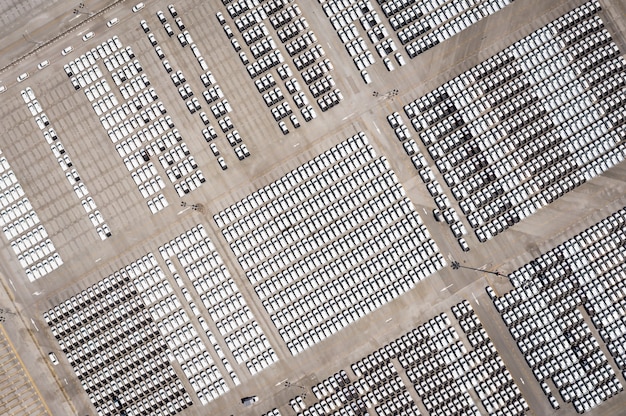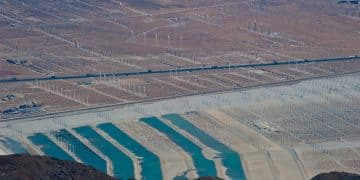Inflation Reduction Act: Key Energy Provision Differences vs. Past Policies

The Inflation Reduction Act (IRA) marks a significant shift from previous US energy policies by offering extensive tax credits and incentives for clean energy development, domestic manufacturing, and emissions reduction, a contrast to the more limited scope and regulatory focus of earlier legislation.
Understanding what are the key differences between the Inflation Reduction Act’s energy provisions and previous US energy policies is crucial for navigating the evolving energy landscape. This article breaks down the major changes and impacts of this landmark legislation.
Inflation Reduction Act: A New Era for US Energy
The Inflation Reduction Act (IRA) represents a paradigm shift in US energy policy. Unlike previous approaches, the IRA leverages substantial financial incentives to drive the adoption of clean energy technologies and reduce carbon emissions.

This section will delve into the foundational aspects of the IRA, comparing its core strategies with those of its predecessors, and setting the stage for a detailed examination of the key differences. We will explore how the IRA is structured to promote a sustainable and economically viable energy future.
Focus on Incentives vs. Regulations
Previous energy policies often relied heavily on regulations and mandates. The IRA, in contrast, prioritizes tax credits, rebates, and grants.
Long-Term Investment and Stability
The IRA provides long-term certainty for clean energy investors and developers, a significant departure from the short-term extensions and uncertainty that characterized past policies.
- Tax Credits: The IRA offers numerous tax credits for renewable energy production, energy efficiency improvements, and clean vehicle purchases.
- Grant Programs: Billions of dollars are allocated to grant programs supporting clean energy technology development, deployment, and infrastructure upgrades.
- Direct Pay Provisions: Certain tax credits can be claimed as direct payments by tax-exempt entities like municipalities and cooperatives, broadening access to clean energy incentives.
In effect, the Inflation Reduction Act represents a strategic move towards incentivizing clean energy adoption through financial mechanisms, fostering a more market-driven transition compared to the regulatory-heavy policies of past administrations.
Financial Incentives: IRA vs. Past Energy Bills
A critical aspect of the Inflation Reduction Act is its unprecedented financial commitment to clean energy. This section explores the scope and nature of these incentives, contrasting them with the more limited financial support provided by earlier energy bills.
The differences in scale and focus are particularly noteworthy, marking a clear shift in how the US government approaches energy policy and investment.
Tax Credits for Renewable Energy
The IRA significantly expands and extends tax credits for solar, wind, and other renewable energy projects, making them more attractive to investors.
Incentives for Energy Efficiency
The act also includes substantial incentives for energy efficiency upgrades in homes and commercial buildings.
The IRA’s financial incentives are designed to be technology-neutral, supporting a broad range of clean energy solutions.
- Production Tax Credit (PTC): Extended and expanded for renewable energy facilities, providing a per-kilowatt-hour incentive.
- Investment Tax Credit (ITC): Enhanced for investments in solar, wind, and other clean energy technologies, offering a percentage-based credit.
- Clean Energy Manufacturing Tax Credit: Incentivizes domestic manufacturing of clean energy equipment and components.
By offering substantial and long-term financial incentives, the IRA aims to de-risk clean energy investments and accelerate the transition to a low-carbon economy, a marked departure from the more modest and short-term financial support offered by previous energy bills.
Impact on Domestic Manufacturing
The Inflation Reduction Act places a strong emphasis on bolstering domestic manufacturing of clean energy technologies. This focus on on-shoring and job creation distinguishes it from previous policies that often lacked a specific manufacturing component.
This section examines how the IRA’s provisions are designed to re-shore manufacturing activities, create jobs in the US, and reduce reliance on foreign supply chains.
Manufacturing Tax Credits
The IRA includes tax credits specifically designed to encourage domestic manufacturing of solar panels, wind turbines, batteries, and other clean energy components.
Supply Chain Security
By promoting domestic manufacturing, the IRA aims to reduce the vulnerability of the US energy sector to disruptions in global supply chains.

The act leverages government procurement to support domestic manufacturers of clean energy products.
- Section 45X Advanced Manufacturing Production Credit: Provides tax credits for the production of eligible components, such as solar wafers, cells, and modules.
- Domestic Content Bonus: Offers an additional tax credit for projects that use domestically manufactured iron and steel.
- Loan Programs: The Department of Energy (DOE) is authorized to provide loans and loan guarantees to support domestic manufacturing projects.
In contrast to previous energy policies, the IRA actively seeks to promote domestic manufacturing through targeted incentives and procurement policies, aiming to create a robust and resilient clean energy supply chain in the United States.
Direct Pay and Tax-Exempt Entities
A notable innovation in the Inflation Reduction Act is the direct pay provision, which allows tax-exempt entities like municipalities, cooperatives, and tribal governments to receive direct payments for certain clean energy tax credits. This mechanism significantly expands access to clean energy incentives.
This section will explore how direct pay works, why it is important, and how it differs from previous policies that primarily benefited private companies with tax liabilities.
Expanding Access to Incentives
Direct pay enables tax-exempt entities to participate in clean energy projects without needing to partner with taxable entities to monetize tax credits.
Community-Scale Projects
Direct pay facilitates community-scale renewable energy projects, such as solar installations on schools, hospitals, and municipal buildings.
Direct pay simplifies the financing and development of clean energy projects for tax-exempt entities.
- Eligible Tax Credits: Direct pay is available for various clean energy tax credits, including the PTC and ITC.
- Refundable Payments: Tax-exempt entities can receive payments equal to the value of the tax credits they earn.
- Reduced Transaction Costs: Direct pay eliminates the need for complex tax equity financing structures, reducing transaction costs.
Unlike previous policies that primarily targeted private companies, the IRA’s direct pay provision democratizes access to clean energy incentives, empowering local governments and non-profit organizations to lead the transition to a sustainable energy future.
Emissions Reduction Targets and Strategies
The Inflation Reduction Act sets ambitious goals for reducing greenhouse gas emissions in the United States. This section will examine the IRA’s emissions reduction targets and the various strategies it employs to achieve them, comparing them with the often less-defined or less-ambitious goals of previous energy policies.
The IRA’s comprehensive approach combines incentives for clean energy deployment with measures to reduce emissions from existing sources.
Economy-Wide Targets
The IRA aims to reduce US greenhouse gas emissions by roughly 40% below 2005 levels by 2030.
Sector-Specific Strategies
The act targets emissions reductions in various sectors, including electricity, transportation, and industry.
The IRA supports the development and deployment of carbon capture and storage technologies.
- Clean Electricity Standard: The IRA incentivizes the deployment of clean electricity sources to decarbonize the power sector.
- Electric Vehicle Incentives: The act provides tax credits for the purchase of electric vehicles to reduce emissions from the transportation sector.
- Methane Emissions Reduction Program: The IRA includes measures to reduce methane emissions from oil and gas operations.
In stark contrast to previous policies that often lacked clear emissions reduction targets or comprehensive strategies, the IRA sets ambitious goals and employs a multi-faceted approach to decarbonize the US economy, marking a significant step towards addressing climate change.
Regulatory Changes and Permitting Reform
While the Inflation Reduction Act primarily relies on incentives, it also includes some regulatory changes and provisions aimed at streamlining the permitting process for clean energy projects. This section examines these regulatory aspects and compares them with the more extensive regulatory frameworks of previous energy policies.
The IRA seeks to balance environmental protection with the need to accelerate the deployment of clean energy infrastructure.
Permitting Streamlining
The act includes provisions to expedite the permitting process for certain clean energy projects on federal lands.
Environmental Reviews
The IRA aims to streamline environmental reviews while ensuring that projects are environmentally sound.
The act directs funding to federal agencies to improve their permitting capacity.
- Interagency Coordination: The IRA promotes coordination among federal agencies to streamline permitting processes.
- Timelines and Deadlines: The act establishes timelines and deadlines for permitting decisions to reduce delays.
- Stakeholder Engagement: The IRA emphasizes stakeholder engagement in the permitting process.
While previous energy policies often focused on detailed regulatory requirements, the IRA seeks to streamline permitting processes to accelerate clean energy development, without sacrificing environmental safeguards.
| Key Aspect | Brief Description |
|---|---|
| 💰 Financial Incentives | Extensive tax credits and rebates for clean energy projects. |
| 🏭 Domestic Manufacturing | Incentives for manufacturing clean energy components in the US. |
| 🎯 Emissions Reduction | Targets a 40% reduction in emissions by 2030. |
| 🤝 Direct Pay | Allows tax-exempt entities to receive direct payments for clean energy credits. |
Frequently Asked Questions
▼
The IRA aims to lower greenhouse gas emissions by roughly 40% below 2005 levels by 2030, mainly by incentivizing clean energy and reducing reliance on fossil fuels through different strategies.
▼
The IRA offers tax credits to encourage domestic production of solar panels, wind turbines, batteries, and other components, improving supply chain security and creating jobs inside the United States.
▼
The Direct Pay provision enables tax-exempt organizations like cities, cooperatives, and tribal governments to get direct payments for particular clean power tax credits, growing access to incentives.
▼
The IRA provides tax credits for Americans to get electric cars, therefore reducing emissions from the transportation sector and boosting the adoption of cleaner cars.
▼
The IRA provides more sizable financial incentives to clean energy than past guidelines, focusing on tax credits and rebates in a technology-neutral technique to accelerate decarbonization.
Conclusion
In conclusion, the Inflation Reduction Act represents a transformative shift in US energy policy, characterized by substantial financial incentives, a focus on domestic manufacturing, and ambitious emissions reduction targets aimed at fostering a sustainable and resilient energy future.





